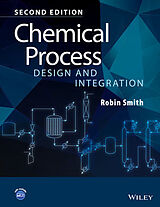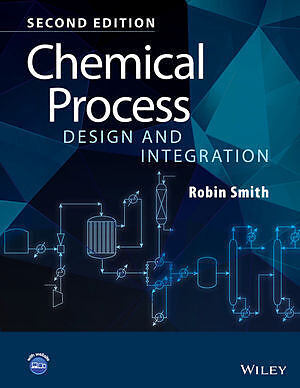Chemical Process Design and Integration
Einband:
Fester Einband
EAN:
9781119990147
Untertitel:
Englisch
Genre:
Chemie
Autor:
Robin (UMIST, UK) Smith
Herausgeber:
Wiley-Blackwell
Auflage:
2 ed
Anzahl Seiten:
928
Erscheinungsdatum:
30.09.2016
ISBN:
978-1-119-99014-7
Written by a highly regarded author with industrial and academic experience, this new edition of an established bestselling book provides practical guidance for students, researchers, and those in chemical engineering. The book includes a new section on sustainable energy, with sections on carbon capture and sequestration, as a result of increasing environmental awareness; and a companion website that includes problems, worked solutions, and Excel spreadsheets to enable students to carry out complex calculations.
Autorentext
Professor Robin Smith is Head of the Centre for Process Integration at the University of Manchester Institute of Science and Technology (UMIST) in the United Kingdom. Before joining UMIST he had extensive industrial experience with Rohm & Haas in process investigation and process design, and with ICI in computer-aided design and process integration. He was a member of the ICI Process Integration Team that pioneered the first industrial applications of process integration design methods. Since joining UMIST he has acted extensively as a consultant in process integration projects. He has published widely in the field of chemical process design and integration, and is a Fellow of the Royal Academy of Engineering, a Fellow of the Institution of Chemical Engineers in the UK and a chartered engineer. In 1992 he was awarded the Hanson Medal of the Institution of Chemical Engineers in the UK for his work on clean process technology.
Inhalt
Preface xiii Acknowledgements xv Nomenclature xvii References 58 1 The Nature of Chemical Process Design and Integration 1 1.1 Chemical Products 1 1.2 Formulation of Design Problems 3 1.3 Synthesis and Simulation 4 1.4 The Hierarchy of Chemical Process Design and Integration 6 1.5 Continuous and Batch Processes 8 1.6 New Design and Retrofit 11 1.7 Reliability, Availability and Maintainability 11 1.8 Process Control 12 1.9 Approaches to Chemical Process Design and Integration 13 1.10 The Nature of Chemical Process Design and Integration - Summary 16 References 17 2 Process Economics 19 2.1 The Role of Process Economics 19 2.2 Capital Cost for New Design 19 2.3 Capital Cost for Retrofit 25 2.4 Annualized Capital Cost 26 2.5 Operating Cost 27 2.6 Simple Economic Criteria 30 2.7 Project Cash Flow and Economic Evaluation 31 2.8 Investment Criteria 33 2.9 Process Economics-Summary 34 2.10 Exercises 34 References 36 3 Optimization 37 3.1 Objective Functions 37 3.2 Single-Variable Optimization 40 3.3 Multivariable Optimization 42 3.4 Constrained Optimization 45 3.5 Linear Programming 47 3.6 Nonlinear Programming 49 3.7 Structural Optimization 50 3.8 Solution of Equations Using Optimization 54 3.9 The Search for Global Optimality 55 3.10 Optimization - Summary 56 3.11 Exercises 56 4 Chemical Reactors I - Reactor Performance 59 4.1 Reaction Path 59 4.2 Types of Reaction Systems 61 4.3 Measures of Reactor Performance 63 4.4 Rate of Reaction 64 4.5 Idealized Reactor Models 65 4.6 Choice of Idealized Reactor Model 73 4.7 Choice of Reactor Performance 76 4.8 Reactor Performance - Summary 77 4.9 Exercises 78 References 79 5 Chemical Reactors II - Reactor Conditions 81 5.1 Reaction Equilibrium 81 5.2 Reactor Temperature 85 5.3 Reactor Pressure 92 5.4 Reactor Phase 93 5.5 Reactor Concentration 94 5.6 Biochemical Reactions 99 5.7 Catalysts 99 5.8 Reactor Conditions - Summary 102 5.9 Exercises 103 References 105 6 Chemical Reactors III - Reactor Configuration 107 6.1 Temperature Control 107 6.2 Catalyst Degradation 111 6.3 Gas-Liquid and Liquid-Liquid Reactors 112 6.4 Reactor Configuration 116 6.5 Reactor Configuration For Heterogeneous Solid-Catalyzed Reactions 121 6.6 Reactor Configuration - Summary 122 6.7 Exercises 122 References 123 7 Separation of Heterogeneous Mixtures 125 7.1 Homogeneous and Heterogeneous Separation 125 7.2 Settling and Sedimentation 126 7.3 Inertial and Centrifugal Separation 130 7.4 Electrostatic Precipitation 131 7.5 Filtration 133 7.6 Scrubbing 134 7.7 Flotation 135 7.8 Drying 136 7.9 Separation of Heterogeneous Mixtures - Summary 137 7.10 Exercises 137 References 138 8 Separation of Homogeneous Fluid Mixtures I - Distillation 139 8.1 Vapor-Liquid Equilibrium 139 8.2 Calculation of Vapor-Liquid Equilibrium 141 8.3 Single-Stage Separation 146 8.4 Distillation 146 8.5 Binary Distillation 150 8.6 Total and Minimum Reflux Conditions for Multicomponent Mixtures 155 8.7 Finite Reflux Conditions for Multicomponent Mixtures 162 8.8 Column Dimensions 164 8.9 Conceptual Design of Distillation 174 8.10 Detailed Design of Distillation 176 8.11 Limitations of Distillation 179 8.12 Separation of Homogeneous Fluid Mixtures by Distillation - Summary 180 8.13 Exercises 180 References 183 9 Separation of Homogeneous Fluid Mixtures II - Other Methods 185 9.1 Absorption and Stripping 185 9.2 Liquid-Liquid Extraction 189 9.3 Adsorption 196 9.4 Membranes 199 9.5 Crystallization 211 9.6 Evaporation 215 9.7 Separation of Homogeneous Fluid Mixtures by Other Methods - Summary 217 9.8 Exercises 217 References 219 10 Distillation Sequencing 221 10.1 Distillation Sequencing using Simple Columns 221 10.2 Practical Constraints Restricting Options 221 10.3 Choice of Sequence for Simple Nonintegrated Distillation Columns 222 10.4 Distillation Sequencing using Columns With More Than Two Products 229 10.5 Distillation Sequencing using Thermal Coupling 231 10.6 Retrofit of Distillation Sequences 236 10.7 Crude Oil Distillation 237 10.8 Structural Optimization of Distillation Sequences 239 10.9 Distillation Sequencing - Summary 242 10.10 Exercises 242 References 245 11 Distillation Sequencing for Azeotropic Distillation 247 11.1 Azeotropic Systems 247 11.2 Change in Pressure 247 11.3 Representation of Azeotropic Distillation 248 11.4 Distillation at Total Reflux Conditions 250 11.5 Distillation at Minimum Reflux Conditions 255 11.6 Distillation at Finite Reflux Conditions 256 11.7 Distillation Sequencing Using an Entrainer 259 11.8 Heterogeneous Azeotropic Distillation 264 11.9 Entrainer Selection 267 11.10 Multicomponent Systems 270 11.11 Trade-Offs in Azeotropic Distillation 270 11.12 Membrane Separation 270 11.13 Distillation Sequencing for Azeotropic Distillation - Summary 271 11.14 Exercises 272 References 273 12 Heat Exchange 275 12.1 Overall Heat Transfer Coefficients 275 12.2 Heat Exchanger Fouling 279 12.3 Temperature Differences in Shell-and-Tube Heat Exchangers 281 12.4 Heat Exchanger Geometry 288 12.5 Allocation of Fluids in Shell-and-Tube Heat Exchangers 294 12.6 Heat Transfer Coefficients and Pressure Drops in Shell-and-Tube Heat Exchangers 294 12.7 Rating and Simulation of Heat Exchangers 301 12.8 Heat Transfer Enhancement 307 12.9 Retrofit of Heat Exchangers 313 12.10 Condensers 316 12.11 Reboilers and Vaporizers 321 12.12 Other Types of Heat Exchanger…

Leider konnten wir für diesen Artikel keine Preise ermitteln ...
billigbuch.ch sucht jetzt für Sie die besten Angebote ...
Die aktuellen Verkaufspreise von 6 Onlineshops werden in Realtime abgefragt.
Sie können das gewünschte Produkt anschliessend direkt beim Anbieter Ihrer Wahl bestellen.
Loading...
Die aktuellen Verkaufspreise von 6 Onlineshops werden in Realtime abgefragt.
Sie können das gewünschte Produkt anschliessend direkt beim Anbieter Ihrer Wahl bestellen.
| # | Onlineshop | Preis CHF | Versand CHF | Total CHF | ||
|---|---|---|---|---|---|---|
| 1 | Seller | 0.00 | 0.00 | 0.00 |
